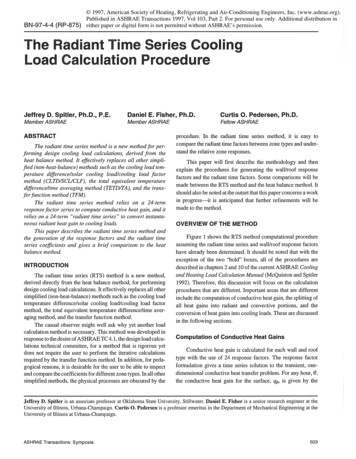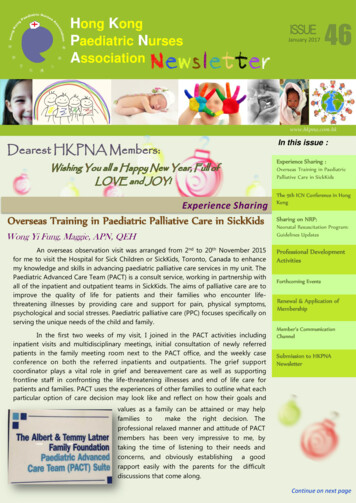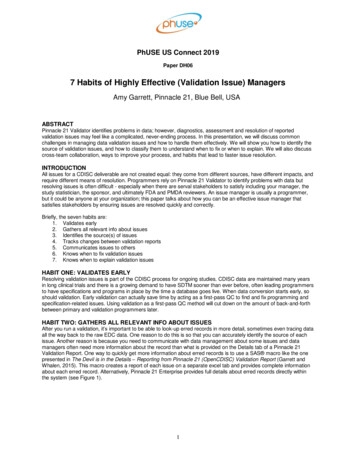
Transcription
Each issue of the Rosicrucian Digest provides members andall interested readers with a compendium of materialsregarding the ongoing flow of the Rosicrucian Timeline.The articles, historical excerpts, art, and literature includedin this Digest span the ages, and are not only interesting inthemselves, but also seek to provide a lasting referenceshelf to stimulate continuing study of all of those factorswhich make up Rosicrucian history and thought. Therefore,we present classical background, historical development,and modern reflections on each of our subjects, using themany forms of primary sources, reflective commentaries,the arts, creative fiction, and poetry. This magazine is dedicated to all the women and menthroughout the ages who have contributed to andperpetuated the wisdom of the Rosicrucian,Western esoteric, Tradition.May we ever be worthy of the light with whichwe have been entrusted.In this issue we present theAncient and Mystical Order Rosae Crucis- the Rosicrucian Order, AMORC from its inspiring beginnings to its far-reachingcontributions to the world today.RosicrucianDigestNo. 22014Page ii
No. 2 - 2014Vol. 92 - No. 2Official Magazine of theWorldwideRosicrucian Order Ordo Rosae Crucis Established in 1915 by the SupremeGrand Lodge of the English LanguageJurisdiction, AMORC, RosicrucianPark, San Jose, CA 95191.Copyright 2014 by the Supreme GrandLodge of AMORC, Inc. All rightsreserved. Republication of any portionof Rosicrucian Digest is prohibitedwithout prior written permission of thepublisher.ROSICRUCIAN DIGEST (ISSN#0035–8339) is published bi-annuallyfor 12.00 per year, single copies 6.00,by the Grand Lodge of the EnglishLanguage Jurisdiction, AMORC,Inc., at 1342 Naglee Ave., San Jose,CA 95191. POSTMASTER: Sendaddress changes to ROSICRUCIANDIGEST at 1342 Naglee Ave., SanJose, CA 95191–0001. The Mystery Schools and the Rosicrucian Order 2Julie Scott, SRCH. Spencer Lewis - Restorer of RosicrucianismChristian Rebisse, FRC9Imagination and CreativityH. Spencer Lewis, FRC16Rosicrucian Initiatic Journeys to Egypt18The Function of a RosicrucianRalph M. Lewis, FRC21Creed of PeaceRalph M. Lewis, FRC25Contribution to Peace26The Science of IntuitionGeorge F. Buletza, PhD, FRC27Rosicrucian Park32AMORC - The Contemporary EraChristian Rebisse, FRC34Rosicrucian Lesson38AMORC Around the World42Rose Croix Journal44Rosicrucian Cultural Center of New York City46Appellatio Fraternitatis Rosae Crucis47Cosmic AttunementChristian Bernard, FRC52Page 1
The Mystery Schools and theRosicrucian Order, AMORCJulie Scott, SRCThe Mystery Schools were centers of study and mystic initiation in the ancient Western worldwhere the mysteries of the Universe, of Nature, and of Humanity were explored. These spiritual centers educated students in natural laws and principles so they could better live in harmonywith them; encouraged introspection in order to know oneself better; and engendered withina feeling of connection with the Great Mystery of the Universe.Today, the Rosicrucian Order, AMORC perpetuates many of the traditions of these ancientMystery Schools and the philosophies that sprang from them. In this article, Grand MasterJulie Scott leads us on a journey through these inspiring ancient sources to Rosicrucianismtoday. Each of the traditions described below has been the focus of one of the past sixteen issues of the Rosicrucian Digest, beginning with mysterious Atlantis to modern Martinism.This issue of the Digest concludes this seventeen-part series, culminating with the RosicrucianOrder, AMORC.o begin, let’s define the word“mystery.” Mystery comes frommysteria—which is made up of theverb, muo, meaning “to close”, as in to closethe mouth (in secrecy) or to close the eyes,and teria meaning festival. According toCarl Kerenyi, one of the leading experts onthe Eleusinian Mysteries, the word mysteriameans, “the festival at which the secret iscommunicated.”1TThe Dictionary of Philosophy and Religion defines the Mystery religions as “Thename given to a group of religious cultspopular in Hellenic and Roman periods.The mystery religions were characterizedby a body of esoteric knowledge and ritualthat allegedly had the power to purify theinitiate and guarantee union with Godand personal immortality. Virtually all ofthe mysteries centered around dying andrising saviors.”2These include the Eleusinian and Orphic Mysteries of ancient Greece and theRosicrucian Roman Mithraic Mysteries. Added toDigestthis list in the Rosicrucian tradition areNo. 2the Egyptian mysteries of Osiris and Isis2014Page 2and the Mystery Schools associated withAkhnaton and his great, great grandfather,Thutmose III, as well as the PythagoreanSchool in Italy.What do we know about these ancientMystery Schools?In some cases, we don’t know a lot,and even if we did, I shouldn’t tell you everything. Secrecy and ambiguity are consistent with these ancient traditions. Theancient Mystery Schools often required anoath of secrecy from its initiates (usuallyunder the penalty of death) and lessons oranswers were often presented in the formof riddles or paradox, as with the famousoracles at Delphi.There is also a lot that has not yet beendiscovered. Egyptology, for example, isa relatively new field. Champollion, theFrench linguist and father of Egyptology,only first announced the deciphering of theancient Egyptian hieroglyphs in 1822. Forcenturies before then, no one knew whatthe hieroglyphs meant. Egyptologists didnot recognize Akhnaton as a pharaoh untilabout 100 years ago because his name had
been expunged from the ancient records.Also, although there are some inscriptionsand texts available to us related to some ofthese traditions (such as the descriptions ofthe rituals associated with the Cult of Isis,recorded by the ancient writers Iamblichusand Apuleuis) definitive texts or inscriptions are rare.There is also the challenge of beingable to accurately interpret them with ourmore modern minds and biases. Many ofthe interpretations of the texts that havebeen found were presented through theperspectives of archaeologists and researchers who wereofteninfluencedby their Victorianupbringings or thedominant culturalor academic theoriesof their day.For example, foryears the prevailingview in Egyptology has been thatthe Pyramid textswere only funerarytexts, a guide for thepharaoh as he traveled to the afterlife.What if, instead,these texts were interpreted from a shamanic perspective,guiding not the dead king, but the shamaninitiate to another plane, from which hereturned with the ability to heal and tocommunicate with those on other planesof existence?Definitive knowledge of what happened in the ancient Mystery Schoolstherefore is limited by; secrecy over theages, a dearth of texts and artifacts availablefor research, and the limits of our understanding of the perspectives of the ancientpeoples, especially their priests, priestesses,and shamans. However, we can piece together the general themes and purposes ofthe ancient Mystery Schools by studyingtheir context, the available inscriptions,temples, texts, etc., and by attuning tothe spirit of the ancient Egyptian, Greek,and Roman people thereby opening ourselves up to other ways of perceiving beyond just intellectual understanding. Wecan reach beyond our own time and spaceto step into the shoes of the ancient mystics, students, and initiates, as they did intheir time. Finally, and most importantly,we can study andexperience the wisdom of these ancienttraditions as it hasbeen passed downthrough the Westernesoteric tradition.Christopher McIntosh, Ph.D. writesin his book, TheRosicrucians, “TheRosicrucian movement is part of a wayof thinking whoseroots go far back intoantiquity and whichcan be described asthe Western esoterictradition. This tradition, drawing onmany sources, hasrun through European history exercising a strong influence,sometimes underground, at other timesflourishing in the open A great revivalof this tradition began in Italy during theRenaissance and opened up a new phasein the development of esoteric thought.From then on it had an assured, if stillsomewhat underground, place in Westernthought.”3McIntosh traces the Rosicrucian movement beginning with Gnosticism, a movement, which had Egypt as its focal pointPage 3
of development, and Hermetism; throughNeoPlatonism, including the Pythagoreanstrain that greatly appealed to Renaissancescholars; to Kabbalah; to the Esoteric Tradition in Germany that set the conditionsfor the release of the Rosicrucian manifestos in the early 1600s; up to modern Rosicrucian movements.The Rosicrucian Order, AMORC traces its tradition back to a “Primordial Tradition.” “This concept first appeared in theRenaissance, especially after the rediscovery of the Corpus Hermeticum, a group ofmysterious texts attributed to an Egyptianpriest, Hermes Trismegistus.”4 Below is thetimeline tracing the Rosicrucian traditionfrom some of its most ancient sources totoday.Rosicrucian Order, AMORCTime LineAtlantis (Prehistory)Plato (ca. 428 – ca. 348 BCE) describedAtlantis in detail in his books, Critias andTimaeus. He stated that his knowledge onthis subject was reported to him by Solon(ca. 640 – 558 BCE) who, according tohis own words, obtained it from Egyptianpriests. Some people believe that Atlantisactually existed and is the cradle of thePrimordial Tradition, which flows throughthe Rosicrucian tradition. This highly sophisticated and spiritual civilization flourished for millennia, until it declined intocorruption, warmongering, and superstition, and finally ended in a cataclysm in9564 BCE. Others believe that Atlantismerely symbolizes the unknown source ofthe Primordial Tradition, representing aprevious “Golden Age.”Predynastic Egypt(ca. 10000 to ca. 3000 BCE)RosicrucianDigestNo. 22014According to the Primordial Tradition,the Atlanteans chose Egypt as the place tolay the foundation for what was to becomePage 4the cultural and spiritual home of newborn antiquity.Dynastic Egypt(ca. 3000 to 30 BCE)Legend tells us that the first King ofEgypt was chosen from among the Atlanteans. Later, Thutmose III (1473 – 1425BCE), in addition to serving as Pharaoh,directed the mystery school at Karnak andorganized the mystery schools together asa single Order. His great, great grandson,Akhnaton, (ca. 1353 – ca.1335 BCE) wasresponsible for introducing monotheism toancient Egypt and inspiring an artistic revolution. After Alexander the Great’s conquest in 332 BCE, Egyptian culture andspirituality blended with Greek Hellenismand was highly influential throughout theMediterranean. Through many historicalpaths this ancient tradition finds a modernmanifestation in the Rosicrucians.Essenes(Second century BCE to 100 CE)The Essenes were mystics who cametogether in spiritual communities throughout Egypt and Israel; one of these centerswas most probably Qumran, where theDead Sea Scrolls were found. Jesus is believed by many to have been a memberof the Essene community. Many of theirpractices paralleled those of the Pythagoreans. Among the different groups of Essenes were the Theraputae near Alexandria, specializing in healing, as describedby Philo. Health of body, soul, and spiritalways figures prominently in the Rosicrucian tradition and its antecedents.Orphic Mysteries(ca. sixth century BCE to 391 CE)The Orphic mysteries were associatedwith the life of the greatest of all musicians– Orpheus. Some mystical texts describehim as being an initiate who actually existed. According to these texts, he spent
The Pythagorean School.twenty years in Egypt and was a member of the mystery school associated withMemphis. However, by the sixth centuryBCE, Orpheus was definitely a mythicalfigure. It was said that Orpheus’s musiccould move even inanimate objects andhis sacred songs told the greatest secretsof the universe. Orphism stressed a strictstandard of ethical and moral conduct.Initiates purified themselves and adoptedascetic practices for the purpose of purging evil and cultivating the Dionysian (Divine) aspect of human behavior. The Orphics abstained from eating meat and wereknown to wear white, symbolic of purity.It is difficult to separate the Orphic andPythagorean traditions.Delphic Mysteries(1700 BCE to 391 CE)Delphi served as the spiritual centerof Greece for over 2,000 years. The Pythias (priestesses) played a fundamental rolein the oracles of Delphi. They were saidto have the power to commune with theinvisible world and to speak on behalf ofthe god, Apollo. The temple of Delphi exerted a tremendous influence in antiquitynot only because of the oracles, but alsobecause it housed a prestigious mysteryschool. Above the portal of the temple ofApollo in Delphi was inscribed the injunction, “Know Thyself.” This is ever the purpose of each Rosicrucian.Pythagorean School(Mid-sixth century to 492 BCE)Delphi.Pythagoras taught about relationships,especially between seemingly disconnectedelements of the universe, such as mathematics and the physical world, and musicand mathematics. Pythagoreans studiedthe laws of the universe in order to bringPage 5
their minds into harmony with Cosmicreality, thereby becoming one with theuniverse. This was their sacred goal in life.Following five years of silence, if foundworthy, Pythagorean postulants (men andwomen) were considered for instructioninto the Mysteries, presented in three degrees—the first, dedicated to the scienceof numbers; the second, to moral and political laws; and the third, to esoteric doctrines. The Pythagorean mystical understanding of the universe has far outlivedthe actual school, including many Greekphilosophers following Pythagoras, andhas influenced much of Western thoughtin one form or another. Rosicrucian philosophy embodies many of these concepts.Eleusis(1800 BCE to 500 CE)The Eleusinian Mysteries arose in Eleusis (12 miles from Athens) before spreading to all of Greece and beyond. The mysteries were based on the myth of Demeter,the goddess of fertility, and her daughter,Persephone. Their story symbolizes thehuman soul’s return, after the death ofthe body, to its universal origin or lovingsource. The Eleusinian initiations werepresented in three stages: the minor expression; the major expression (lasting ninedays); and the highest of the three – the epopteia (meaning “the state of having seen”).These Mysteries were so important thatduring antiquity the whole Greek worldheld a 55-day truce to permit travel to andfrom Eleusis. The progressive concept ofinitiation and its effect on the individual iscontinued in Rosicrucian Initiation.Isis Mysteries(Fourth century BCE to sixth century CE)As the Hellenized Egyptian mysteries of Isis spread throughout the MediterRosicrucian ranean world, from the Middle East toBritain, they soon became one the mostDigestNo. 2widespread exports of Egyptian spiritual2014Page 6ity. Many suggest that the Isis-Horus paircontinues in images of the Virgin andChild. The ancient writers, Apuleius, inhis book, The Golden Ass, and Iamblichusin The Egyptian Mysteries, described in detail the rituals of the Isis Mysteries. TheseMysteries addressed the desire for personaltranscendence and salvation and presenteda powerful image of the protective, nurturing, and victorious Divine Feminine.Mithraic Mysteries(Second century BCE to fifth century CE)The Mithraic Mysteries were an initiatic mystery school in which studentswere gradually introduced to astronomical truths through symbol, and how thisknowledge could lead the seeker to unionwith the power behind all existence. TheMithraic Mysteries included a series ofseven initiations in which the candidatesunderwent trials. This combination of scientific study, symbolic initiation, and cosmic union is a feature of Rosicrucian work.
Hermetism(First century BCE to the present day)Based on the writings attributed toHermes Trismegistus (the Hellenized formof the Egyptian God, Thoth) the Hermetictradition was honored by practitioners ofEgyptian, Greco-Roman, Jewish, Christian, and later Islamic religions, and manybelieve it represents a continuity of theteachings in the Egyptian Temples andMystery Schools. Hermetism inspiredmany Renaissance mystics and scholars,and modern evolutions of this traditionare often referred to as Hermeticism. Hermetism emphasizes the organic connectionof the Divine with the earthly (“As above,so below”) and points the way of return tothe source of being. Rosicrucian philosophy is heir to the Hermetic tradition.Gnosticism(First century CE to fourteenth century CE)One of the early varieties of the JudeoChristian spiritual tradition, the variousgroups we call “Gnostics” today emphasized the individual coming to personaland interior experiential knowledge (Gnosis) of the transcendent Divine One whichis within the innermost being. This Gnosisthen allows the person to enter into unionwith the source of all existence. Persecutedin the Mediterranean in the fourth to fifthcenturies CE, Gnostics continued theirspiritual practice, moving to Eastern Europe, the Middle East, Northern Italy, andfinally Southern France, where they weredriven underground in the fourteenth century CE. The interior center of knowledgeis a familiar theme that manifests in Rosicrucian studies and practice.Neoplatonism(Third – sixth centuries CE, influential tothe present day)The last flowering of the ClassicalGreek philosophical tradition, the Neoplatonists synthesized the approaches of Plato,Aristotle, Pythagoras, and others, address-ing the individual yearning for salvationfrom a philosophical viewpoint. Neoplatonism posits a single source from whichall existence emanates and with which anindividual soul can be mystically united.This philosophical school provided waysthat the individual could ascend the ladderof being through theoria – contemplationof the Divine. Neoplatonic approacheshave continued to be of tremendous importance in Jewish, Eastern and WesternChristian, and Islamic Mysticism, as wellas the esoteric schools, including Rosicrucian thought.Kabbalah(From the beginning of Judaism to thepresent day)The word Kabbalah means “tradition”or “received tradition.” At the beginningit was taught only by word of mouth andin the greatest secrecy. The primary booksthat make up the foundational writingsof Kabbalah include a meditation manualcalled the Sepher Yezirah, or “Book of Formation,” whose first date of appearance inwritten form is unknown, but whose oralteachings date back before the first century; and the Zohar, known as the “Bookof Splendor”, first printed in the late thirteenth century. There are strong Kabbalistic connections to Neoplatonism, Rosicrucianism, and Martinism.Alchemy(Originated in or through Egypt, firstwritten documents in third century CE tothe present day)It is said that Hermes Trismegistus, towhom the “Emerald Tablet” is attributed,instituted alchemy so as to “manifest onEarth the power and wisdom of the deities.” The goal of the alchemist is to transmute that which is base to that which ispure. Dr. Carl Jung understood alchemyto represent the process of self-realization.Alchemy includes physical alchemy (forexample, turning lead into gold) and spiriPage 7
tual alchemy (personal transformation.) Itsconcepts are part of the Rosicrucian curriculum.Rosicrucianism(1614 to present day)The Rosicrucian tradition emerged inEurope with the publication of the threeRosicrucian manifestos, Fama Fraternitatis, Confessio Fraternitatis, and ChymicalWedding of Christian Rosenkreuz; published in 1614, 1615, and 1616. For years,Europe had been embroiled in religious,political, and social strife and many longedfor a “new Reformation” aimed at disarming the superstition and religious intolerance of the time. The manifestos weremost likely the work of “the TubingenCircle,” a group of thirty German scholarsand students who were passionate aboutalchemy, Hermeticism, Kabbalah, astrology, naometry, and Christian Mysticism.The manifestos enjoyed considerable success and circulated throughout Europe.Many philosophers of the time becameaware of their message; among them Francis Bacon and John Amos Comenius arementioned most often. In 1623, the Rosicrucians posted placards on the walls ofParis announcing that the Brothers of theRose Cross were staying “visible and invisible” in their city. Today, the RosicrucianRosicrucianOrder, AMORC perpetuates the RosicruDigestNo. 2cian tradition worldwide.2014Page 8Martinism(Eighteenth century to the present day)From a historical perspective, theorigins of Martinism go back to an eighteenth century organization known as theOrder of the Élus-Cohen, founded byMartinès de Pasqually (1717-1774). TheTraditional Martinist Order is an initiaticOrder and a school of moral chivalry basedessentially on Judeo-Christian mysticism.Its name is derived from that of LouisClaude de Saint-Martin (1743-1803), theFrench mystic and author, who wrote under the pseudonym of “the Unknown Philosopher.” It was formed into an Order byGérard Encausse, MD, known in esotericcircles as Papus, and Augustin Chaboseauin the late nineteenth century, and is nowconducted under the auspices of the Rosicrucian Order, AMORC.Rosicrucian Order, AMORC(1915 to the present day)In 1909 Harvey Spencer Lewis traveled to France where he accepted from theMasters of the Order the charter to reestablish the Rosicrucian tradition in America in 1915. Since then the Ancient andMystical Order Rosae Crucis, also knownas the Rosicrucian Order, AMORC, hasserved as a spiritual path to hundreds ofthousands of women and men throughout the world and continues to perpetuatemany of the traditions of the ancient Mystery Schools and the important philosophies that sprang from them.ENDNOTES1. Carl Kerenyi, Eleusis: Archetypal Image of Mother andDaughter. Translated by Ralph Manheim (New York:Schocken Books, 1967/1977), 46.2. William L. Reese, Dictionary of Philosophy and Religion (Atlantic Highlands, NJ: Humanities Press International, 1996), 501.3. Christopher McIntosh, The Rosicrucians (York Beach,ME: Samuel Weiser, Inc., 1997).4. Christian Rebisse, Rosicrucian History and Mysteries(San Jose, CA: Grand Lodge of the English LanguageJurisdiction, AMORC, 2005), 3.
H. Spencer LewisRestorer of RosicrucianismChristian Rebisse, FRCThe Rosicrucian Order, AMORC is one of the most dynamic philosophical and initiaticorganizations in the world. Rosicrucians are men and women who study natural laws inorder to live in harmony with them.The roots of the Rosicrucian Order go back to early seventeenth century Europe, with a traditional history that goes back much further than that, all the way back to the Ancient MysterySchools of Egypt and Greece.In this article Rosicrucian historian Christian Rebisse presents the inspiring life and vision ofAMORC’s founder, H. Spencer Lewis – Restorer of Rosicrucianism.activities of the Metropolitan Temple ofNew York City also known as the Churchof the Open Door. He loved to sing in thechoir, and he listened attentively to thesermons of Dr. S. Parkes Cadman, thechurch pastor and a pioneering radio minister. H. Spencer Lewis often spent his freetime meditating in this church, and it washere that he had his first mystical experiences. These experiences had such an impact on his soul that he was led to questionhimself about the profound nature of humanity and the possibility of establishing adialogue between the soul and the higherworlds.arvey Spencer Lewis was born onNovember 25, 1883 in Frenchtown, New Jersey. A few yearslater his family moved to nearby New YorkCity where he was raised.HH. Spencer Lewis’s family environmentcontributed much to the development ofhis mystical sensitivity. Not content withsimply attending church on Sunday; thefamily read and also discussed the Bible athome. Until he was sixteen years old youngHarvey participated enthusiastically in theIn March 1903 H. Spencer Lewis married Mollie Goldsmith, and the followingyear they had a son, Ralph Maxwell Lewis.A Mystical ExperienceIn the spring of 1908, on the Thursday after Easter, while seated in a pew tomeditate, he had a mystical experience thatwould affect the rest of his life. During thisexperience, he came to understand that theknowledge he sought could not be foundin books, but rather deep within himself.He was also convinced that he had to goto France so as to come in contact withRosicrucians. This mystical experience leftPage 9
a profound impression upon H. SpencerLewis and became the starting point forhis “Pilgrim’s Journey to the East.”ommended that his American visitor travelto southern France, where he would receivefurther instructions.In the hope of obtaining some information regarding Rosicrucianism inFrance, he decided to write to a Parisianbookseller whose catalogue he had obtained. We have not succeeded in identifying this individual, however this personcontacted H. Spencer Lewis with the following reply:ToulouseIf you came to Paris and found it convenient to call at the Studio of M. —,the professor of languages at No. —,Blvd. St. Germain, he might be able totell you something of the circle of whichyou inquire. It might be advisable tohand him this note. Certainly a letter tohim announcing your coming (by dateand name of boat) would be courteous.The Journey to FranceAlthough his financial situation didnot permit him to consider such a voyage,an unexpected opportunity presented itselfthe following week. His father, Aaron Lewis, an expert in authenticating documentsas well as a renowned genealogist, neededan assistant while conducting research inFrance for the Rockefeller family. On July24, 1909, the two men sailed for Europeon the Amerika, of the Hamburg AmerikaLine. On Sunday, August 1, the ship arrived at Cherbourg, and the two travelersset off for Paris by train. The days that followed were entirely devoted to genealogical research, and it was only in the following week that H. Spencer Lewis was ableto visit the bookshop and the professor oflanguages on Boulevard Saint-Germain. “APilgrim’s Journey to the East” reported hismeetings with the professor on Saturday,August 7, and on Monday, August 9. Thisman was about forty-five years old, spokeperfect English, and asked many probingRosicrucianquestions to determine Lewis’s intentions.DigestAt the end of the second meeting, he recNo. 22014Page 10Once again good fortune (or maybemore appropriately, Divine Providence)smiled upon our traveler, because his father had just planned to travel to southernFrance where he could continue his genealogical research for the Rockefeller family.On Tuesday, August 10, the two men leftParis, and following some adventures thatH. Spencer Lewis interpreted as his having been put to the test, they arrived inToulouse on Wednesday. On the following day, his father resumed his work andprobably went to the Donjon (Keep orOld Tower) to consult the city archives.Meanwhile, H. Spencer Lewis went to theSalle des Illustres (Gallery of the Illustrious) of the Capitol, where he met an individual who was instrumental in bringinghis quest to a successful conclusion. Aftera brief discussion, this person gave him apiece of paper on which was written thename of the street where he should go soas to meet some Rosicrucians.H. Spencer Lewis does not disclose thename of this individual, but merely indicates that his profession was photography.Later, Ralph M. Lewis, his son, indicatedthat this person was an eminent photographer. In all likelihood, he was ClovisLassalle, a photographer who specializedin the fine arts, archeology, commerce, andindustry. This hypothesis is confirmed bythe fact that H. Spencer Lewis’s personalarchives contain a letter that Lassalle wroteto him on August 26, 1909.Around three o’clock in the afternoon,Lewis engaged a taxi and went to the address provided. After passing throughthe old town of Tolosa, he arrived at astone edifice encircled by high walls andsituated on a hill. It was in this castle that,according to “A Pilgrim’s Journey to the
East,” he was initiated into the Rosicrucian Order. Although this text does notgive any details regarding this ceremony,his autobiography provides some intriguing information. We learn that the personwho greeted Lewis was Count Raynaud E.de Bellcastle-Ligne, a seventy-eight yearold man, who lived here with his widoweddaughter and whose means of living weremodest, despite his noble origins. Speaking perfect English, he conducted Lewis toa drawing room where he questioned himabout the psychic research he conducted inAmerica, and showed great interest in hisvisitor’s previous mystical experiences.At the end of the interview, Count deBellcastle-Ligne informed our pilgrim thatthe moment had now come for him to beinitiated and asked whether he felt ready toconfront the “terror of the threshold.” Hewas then led to the second floor of the chateau where he was shown what remainedof an ancient Rosicrucian lodge. The countindicated that this temple had not beenused for more than sixty years, althoughit had been visited by a few Freemasonson several occasions until 1890. His fatherhad been the last presiding officer.The conversation continued until thecount stopped before an iron door to tellhis visitor that he must now enter threechambers one after the other, “alone withGod and his Master.” Carrying out thecommand, Lewis entered the first room,an antechamber. He then went into thesecond room, a darkened place where heunderwent the “test of the threshold”; hethen had a mystical experience where hesensed once again the presence of the invisible being who had manifested to him theprevious year. He finally came to the thirdroom where the count awaited. The latterexplained to him that this room no longerhad the decorations or furnishings it oncehad, and consequently he was forced toadapt the initiation ceremony. The countled him to different places in the chamberand communicated the secret meaning ofthis ritual.Now considering his visitor to be initiated, the old master led him into a littleroom. He recommended that t
Atlantis in detail in his books, Critias and Timaeus. He stated that his knowledge on this subject was reported to him by Solon (ca. 640 – 558 BCE) who, according to his own words, obtained it from Egyptian priests. Some people believe that Atlantis actually existed and is th











